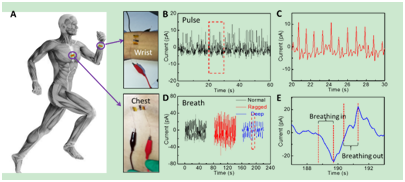
Prof. PingAn Hu
Harbin Institute of Technology (HIT), China
Title: Bio-inspired skin electronics and optoelectronics
Abstract:
Bio-inspired devices of electronic-skins and biomimetic eyes, mimicking certain functionalities of human skin and eye, have attracted considerable interest in the past decade. Bio-inspired devices including E-skins and Biomimetic eyes can be used in wearable health-monitoring de-vices and in autonomous artificial intelligence systems such as robots. Two-dimensional (2D) layered semiconductors have emerged as a highly attractive class of materials for flexible and wearable strain sensor-centric devices such as electronic-skin (e-skin). The processes for patterned 2D films including shield mask growth and soft lithography have been discussed, and optimization of electronics have been studied, and high sensitivity e-skin with excellent spatial resolution have been developed.

Figure 1. Wearable electronics for monitoring health
References
1. Y Hu, M Dai, W Feng, X Zhang, F Gao, S Zhang, B Tan, J Zhang, Y. Shuai, Y. Fu, and P A Hu*,Ultra-low power optical synapses based on MoS2 layers by indium-induced surface charge doping for biomimetic eyesAdv Mater, 2021,doi/epdf/10.1002/adma.202104960
2. J Zhang, G Feng, P A Hu*, A vertical transistor with a sub-1-nm channel, Nature Electronics, 2021, 325-325
3. Y Hu, M Dai, W Feng, X Zhang, S Zhang, B Tan, H Shang, Y Q Fu and P A Hu*, Monolayer hydrophilic MoS2 with strong charge trapping for atomically thin neuromorphic vision systems, Materials Horizons, 2020, 7 3316-3324
4. MJ Dai, et al, Two-Dimensional van der Waals Materials with Aligned In-Plane Po-larization and Large Piezoelectric Effect for Self-Powered Piezoelec-tric Sensors, 2019,NanoLetter, In press
5. Wei Zheng, et al , Kirigami-inspired highly stretchable nanoscale devices using multi-dimensional deformation of monolayer MoS2, Chem Mater, 2018, 30 , 6063-6070
6. Zhang, J, et al, Highly sensitive flexible three-axis tactilesensors based on the interface contact resistance of microstructuredgraphene. Nanoscale,2018,10 , 7387-7395
7. W Feng, W Zheng, XS Chen, G Liu, T Hasan , WW Cao, P A Hu*, Sensitive Electronic-Skin Strain Sensor Array Based on the Patterned Two-Dimensional α-In2Se3,Chem Mater, 2016, 28, 4278−4283
Biography:
Dr. PingAn Hu is a Professor at Harbin Institute of Technology (HIT), selected for National Talent Program, 2022, 2023 Elsevier Highly Cited Chinese Researchers. He obtained his Ph.D degree from Institute of Chemistry, Chinese Academy of Science(2004), then he worked as a JSPS research fellow at Waseda University(2004-2006), Japan, and a Research Associate in University of Cambridge (2006-2009). He has extensive experience in material science, advanced electronics and optoelectronics,and biosensors. He published about 200 SCI papers in highly qualified international journals such as Nature Electronics, Nature Communication, Physical Review Letter, Journal of American Chemical Society and Advanced Materials. He has been invited as regular reviewers for over 20 international journals.